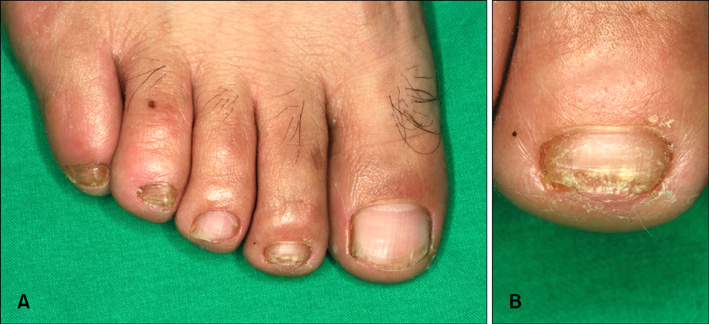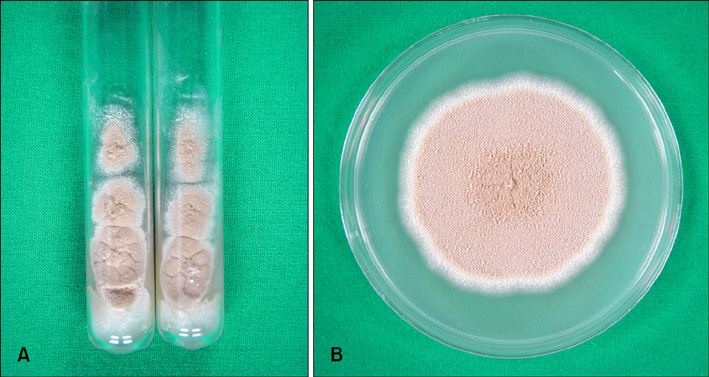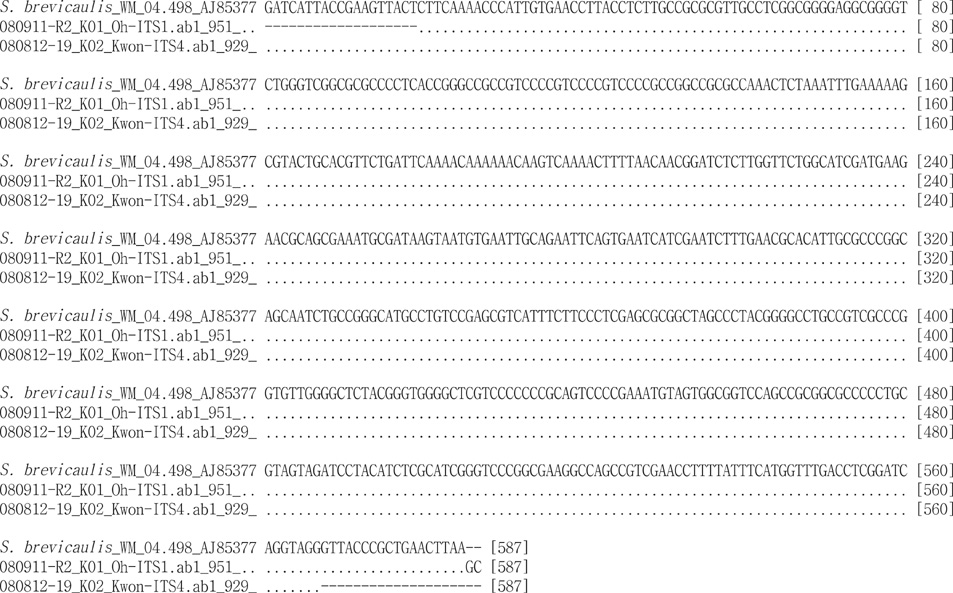Ann Dermatol.
2012 May;24(2):209-213.
Onychomycosis Caused by Scopulariopsis brevicaulis: Report of Two Cases
- Affiliations
-
- 1Department of Dermatology, College of Medicine, Dongguk University, Gyeongju, Korea. smg@dongguk.ac.kr
- 2Department of Laboratory Medicine, College of Medicine, Dongguk University, Gyeongju, Korea.
- 3Department of Microbiology, College of Medicine, Dongguk University, Gyeongju, Korea.
- 4Department of Dermatology, College of Medicine, Yeungnam University, Daegu, Korea.
Abstract
- Onychomycosis is usually caused by dermatophytes, but some nondermatophytic molds and yeasts are also associated with invasion of nails. Scopulariopsis brevicaulis is a nondermatophytic mold found in soil as a saprophyte. We report two cases of onychomycosis caused by S. brevicaulis in a 48-year-old male and a 79-year-old female. The two patients presented with a typical distal and lateral subungual onychomycosis. Direct microscopic examination of the potassium hydroxide preparation revealed fungal elements. From toenail lesions of the patients, brown colonies with powdery surface, which are a characteristic of S. brevicaulis, were cultured on two Sabouraud's dextrose agar plates. Three cultures taken from nail plates within a 2-week interval yielded similar findings. Numerous branched conidiophores with chains of rough walled, lemon-shaped conidia were observed in slide culture by light microscopy and scanning electron microscopy. The nucleotide sequences of the internal transcribed spacer for the two clinical isolates were identical to that of S. brevicaulis strain WM 04.498. To date, a total of 13 cases of S. brevicaulis onychomycosis including the two present cases have been reported in Korea. Mean age of the patients was 46.1 years, with a higher prevalence in males (69.2%). Toenail involvement was observed in all cases including a case involving both fingernail and toenail. The most frequent clinical presentation was distal and lateral subungual onychomycosis in 12 cases, while one case was proximal subungual onychomycosis.
Keyword
MeSH Terms
-
Agar
Aged
Arthrodermataceae
Base Sequence
Female
Fungi
Glucose
Humans
Hydroxides
Korea
Light
Male
Microscopy
Microscopy, Electron, Scanning
Middle Aged
Nails
Onychomycosis
Potassium
Potassium Compounds
Prevalence
Scopulariopsis
Soil
Spores, Fungal
Sprains and Strains
Yeasts
Agar
Glucose
Hydroxides
Potassium
Potassium Compounds
Soil
Figure
Reference
-
1. Verma S, Heffernan MP. Wolff K, Goldsmith LA, Katz SI, Gilchrest BA, Paller AS, Leffell DJ, editors. Superficial fungal infection: dermatophytosis, onychomycosis, Tinea Nigra, Piedra. Fitzpatrick's dermatology in general medicine. 2008. 7th ed. New York: McGraw-Hill;1807–1821.2. Bruynzeel I, Starink TM. Granulomatous skin infection caused by Scopulariopsis brevicaulis. J Am Acad Dermatol. 1998. 39:365–367.3. Tosti A, Piraccini BM, Lorenzi S. Onychomycosis caused by nondermatophytic molds: clinical features and response to treatment of 59 cases. J Am Acad Dermatol. 2000. 42:217–224.
Article4. Gianni C, Cerri A, Crosti C. Non-dermatophytic onychomycosis. An understimated entity? A study of 51 cases. Mycoses. 2000. 43:29–33.
Article5. Moreno G, Arenas R. Other fungi causing onychomycosis. Clin Dermatol. 2010. 28:160–163.
Article6. Kim SC, Chon TH, Kim HU. Onychomycosis due to Scopulariopsis brevicaulis. Korean J Dermatol. 2000. 38:1566–1568.7. Kim YJ, Lim SW, Suh MK, Choi JH, Bang JS, Lee JW, et al. Four cases of toenail onychomycosis caused by Scopulariopsis brevicaulis. Korean J Med Mycol. 2001. 6:97–103.8. Kwon-Chung KJ, Bennett JE. Medical mycology. 1992. Philadelphia: Lea & Febiger;752–755.9. Oh BJ, Chae MJ, Cho D, Kee SJ, Shin MG, Shin JH, et al. Infection with Scopulariopsis brevicaulis after Cosmetic Surgery of the Face. Korean J Lab Med. 2006. 26:32–35.
Article10. De Hoog GS, Guarro J, Gene J, Figueras MJ. Atlas of clinical fungi. 2000. 2nd ed. Virgili: Centraalbureau voor Schimmelcultures;906–908.11. Lim SW, Suh MK, Ha GY. Clinical features and identification of etiologic agents in onychomycosis (1999-2002). Korean J Dermatol. 2004. 42:53–60.12. Onsberg P. Scopulariopsis brevicaulis in nails. Dermatologica. 1980. 161:259–264.13. Baran R, Hay RJ, Tosti A, Haneke E. A new classification of onychomycosis. Br J Dermatol. 1998. 139:567–571.
Article14. Arrese JE, Piérard-Franchimont C, Piérard GE. Unusual mould infection of the human stratum corneum. J Med Vet Mycol. 1997. 35:225–227.
Article15. English MP. Nails and fungi. Br J Dermatol. 1976. 94:697–701.
Article16. Makimura K, Tamura Y, Mochizuki T, Hasegawa A, Tajiri Y, Hanazawa R, et al. Phylogenetic classification and species identification of dermatophyte strains based on DNA sequences of nuclear ribosomal internal transcribed spacer 1 regions. J Clin Microbiol. 1999. 37:920–924.
Article17. Santos DA, Hamdan JS. In vitro antifungal oral drug and drug-combination activity against onychomycosis causative dermatophytes. Med Mycol. 2006. 44:357–362.
Article18. Tosti A, Piraccini BM, Stinchi C, Lorenzi S. Onychomycosis due to Scopulariopsis brevicaulis: clinical features and response to systemic antifungals. Br J Dermatol. 1996. 135:799–802.
Article19. Nolting S, Brautigam M, Weidinger G. Terbinafine in onychomycosis with involvement by non-dermatophytic fungi. Br J Dermatol. 1994. 130:Suppl 43. 16–21.
Article20. De Doncker PR, Scher RK, Baran RL, Decroix J, Degreef HJ, Roseeuw DI, et al. Itraconazole therapy is effective for pedal onychomycosis caused by some nondermatophyte molds and in mixed infection with dermatophytes and molds: a multicenter study with 36 patients. J Am Acad Dermatol. 1997. 36:173–177.
Article
- Full Text Links
- Actions
-
Cited
- CITED
-
- Close
- Share
- Similar articles
-
- Four Cases of Toenail Onychomycosis Caused by Scopulariopsis brevicaulis
- Infection with Scopulariopsis brevicaulis after Cosmetic Surgery of the Face
- First Record of the Complete Mitochondrial Genome of a Saprotrophic and Opportunistic Human Pathogenic Fungus, Scopulariopsis brevicaulis
- A Probable Case of Alternarial Onychomycosis
- Onychomycosis Due to Nondermatophytic Molds





